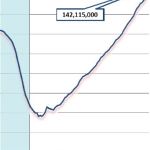26 Oct The economy: What to look for in the year ahead

John Traynor, Chief Investment Officer at People’s United Bank Wealth Management, seems optimistic for the growth of the New England economy. In his outlook for 2016, he recently told members of Corporate Partners at the University of Southern Maine that key economic indicators were trending in a modest but positive direction. Though he offered a few cautionary notes, his presentation was filled with good data and illustrations that supported his optimism. So why the confidence and what issues should keep us awake?
Much of the discussion centered around petroleum production as energy remains central to the fortunes of both consumers and industry. The forecast noted that since 1918, the average inflation adjusted cost for a gallon of gas has been $2.60. Currently, the price of a gallon of gas in the United States is about $2.40. That compares to nearly $3.50 a gallon just two years ago. Those energy savings go straight to the bottom line of households and businesses alike.
Another positive factor is the early signs of home buying often followed by the purchase of home goods (linens, furniture, electronics, fixtures, etc.). An early indicator for home buying demand is the formation of households. Kids are leaving their parent’s cellars, renting apartments and buying houses. Since last December, an average of 1.86 million households have been formed per month. The Peoples forecast also noted that housing prices have been more affordable.
The auto industry is producing at close to capacity with an annualized 18.2 million vehicles being manufactured. The average age of light vehicles is the U.S. is 11.4 years. Though that speaks, perhaps, to better quality, those cars and light trucks will soon begin to age out. If consumer confidence reflects the growth of the economy, auto dealers should have a good period of sales not too far ahead.
A cautionary note, however, is that while the U.S. has gained more than 12 million jobs since the beginning of 2010, a huge number of those jobs are part time. Wages will rise, however, when qualified labor becomes more scarce.
In manufacturing, the U.S. is outpacing much of the world in terms of wage growth (3%) matching productivity gains (3%). In other words, growth in manufacturing is paying for itself while other nations are seeing wage inflation without equal gains in productivity. Going forward, that may give us a competitive edge in world markets though the value of the U.S. dollar must also to be competitive.
Now, let’s talk about age. While the Northeast has a decidedly older population, states such as Maine are beginning to see the influx of younger workers from Southern New England. Of those who moved to Maine between 2005 and 2010, more than 60 percent were under 35 years of age. Nationally, the trend is positive, as well. Over the next 45 years, the U.S. should see 37 percent growth in the population that is 15 to 64 years of age while China will experience a decline of 10 percent and Europe will dip by 21 percent. If we can sustain our economy and harness that pool of talent, we may experience long term prosperity relative to the rest of the industrialized world.
We encourage you to join USM Corporate Partners
for their monthly briefings. You’ll come away better educated to make informed decisions about your future.



